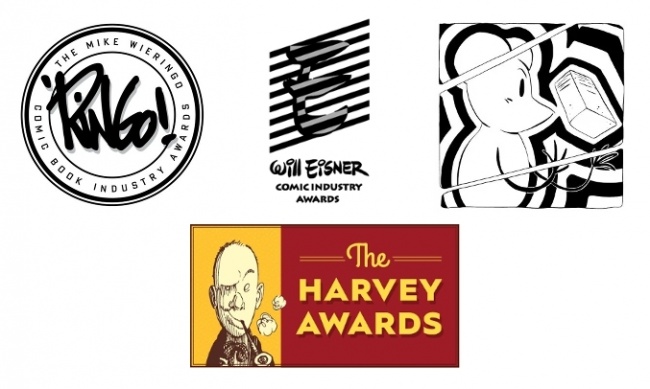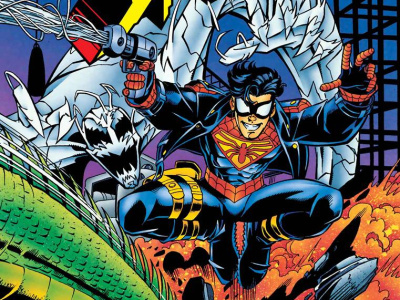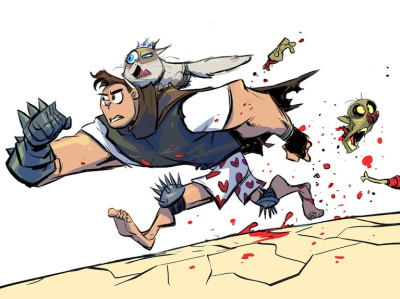Considering all the good that awards do for the industry and how much effort goes into them, it seems reasonable to expect the awards to correspond to the things we actually want to recognize about today’s comics industry. There’s no point giving an award for, say, "best comic of the year with a red cover," even if that category might happen to draw some interesting nominations, right?
And yet, in today’s crowded field of awards, we see lots of distinctions being made on the basis of stuff that doesn’t really matter, or used to matter but doesn’t anymore. And we’ve got categories that are so broad they end up including work so different that comparing them is practically meaningless. To wit…
Digital, print – who cares? Many awards have separate categories for digital comics vs. print comics. At one time, there might have been a good reason to distinguish between these two distribution methods, largely because of the kind of work that was being done exclusively for digital. These days, almost every print book gets a simultaneous digital release, and most digital work is eventually collected in print form.
Serialized web comics are their own thing, but they’re not importantly different in style or audience from similar stuff distributed in print via zines and minicomics. Something like The Nib, nominated in lots of "best digital" categories this year, is cool, but maybe should be recognized for the quality of its content and commentary, not by whether you read it on a screen instead of a page.
The only time digital actually matters is when the work uses some unique attribute of being digital – interactivity, AR/VR, Madefire’s sort-of-animated motion books, or the kind of crazy infinite-canvas experiments that Randall Munroe does from time to time – but awards for digital comics don’t actually judge for stuff like that; they just create an arbitrary distinction. Let’s do away with that and judge digital-first work in whatever category it belongs in relative to content, style and audience.
End the tyranny of geography. Another set of categories beyond its sell-by date are the specialized awards for European comics and manga. Yes, these represent different styles and traditions from American comics. And up until recently, the comics industries in those places presented a much broader range of genres and styles than could be found here. But no more. Many American graphic novelists work in styles that look European or Asian. Plenty of Europeans work in manga style, as do creators from elsewhere in the world. Do awards really want to get into the business of identifying "what is manga?" or what constitutes an authentic contribution to any regional comics tradition?
Perhaps it makes sense to honor work on the basis of geography if your award is set up that way – for example, the Shusters, for Canadian work. Otherwise, seems like another increasingly arbitrary distinction, and high-quality international work from anywhere should go up against the best American work that’s aiming for the same audience and market segment.
The perils of poor categorization. OK, these are gripes many of us have had over the years, but what’s the real harm, you might ask. I t’s this: when you give have outdated or irrelevant categories for your awards, you are not only recognizing distinctions that don’t really mean much to readers, you’re also lumping a bunch of stuff together that don’t have much in common, which risks confusing readers, buyers, press and retailers right when they need the most guidance.
Take, for example, the Eisner Award nominees for "Best Graphic Album – Reprint," a format-based category which this year included Jason Lutes’ historical graphic novel Berlin, Carolyn Nowak’s YA-oriented Girls Town, Ezra Clayan Daniels’ genre-bending Upgrade Soul, Hartley Lin’s literary slice-of-life Young Frances, and Tom King and Gabriel Hernandez Walta’s The Vision, a Marvel superhero comic (albeit a weird one). Every one of these titles is excellent, but if I were a judge, I wouldn’t know where to start with a list like this. The fact that The Vision ended up with the award says nothing except that voters know who Tom King is.
I understand why the Eisners and other awards have categories like this. They reflect a snapshot of an earlier moment in the industry when certain things like trade format or whether the work had previously appeared or not mattered more than what the comics were actually about or who they were for.
Today, what matters is there are three completely separate markets for comics: direct market, adult-oriented trade books, and kids/teens/YA. Great work is being produced in each of those areas, but the definition of "great" varies tremendously depending on what the creators are trying to accomplish and who the publishers are trying to reach. It serves no one to mix those streams, any more than it makes sense to give out awards based on the color of the cover.
We owe it to the creators and publishers to judge their work on its own terms, and we owe it to readers, retailers, press and fans to be a little clearer about comparing apples to apples, given how many different types of content now use comics as a medium and a platform.
A Modest Proposal. What if we reorganized the awards around the content types and audience segments that reflect today’s comics market, rather than the old criteria of distribution method, format, and geography? That way, overall categories would include:
- Best work on superhero or licensed comics (lumping these together, because DC and Marvel basically act like licensors in how they treat their superhero comic lines these days)
- Best genre work (sci-fi, fantasy, horror, mystery, etc.)
- Best humorous work (all ages)
- Best general fiction or memoir
- Best nonfiction
- Best kids, teens and YA works (most awards are already pretty good about this)
Within those categories, you could subdivide long and short form works if the awards think that’s desirable or useful. But you don’t really need to distinguish between digital, periodical or trade, since everything eventually comes out in digital and trade anyway.
This would serve to pit the best work by Marvel, DC and various licensed stuff against each other, since it’s basically going for the same aesthetic and readership; create a carve-out for indie and creator-owned work sold through the DM (like most Image Comics, Dark Horse Comics, Ahoy, TKO and suchlike), and for humor stuff, both of which are different enough from superheroes; and then have the adult-oriented fiction and non-fiction duke it out without having to compete in a popularity contest with fan-favorite mainstream creators.
This might sound like a lot, but if you scrap some of the meaningless categories that exist in all the major awards, this change wouldn’t result in more categories and it might result in fewer. Whatever the case, it would give all the stakeholders a little more clarity about what is being recognized.
The opinions expressed in this column are solely those of the writer, and do not necessarily reflect the views of the editorial staff of ICv2.com.
Rob Salkowitz (@robsalk) is the author of Comic-Con and the Business of Pop Culture.









